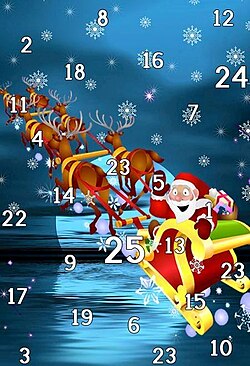
An Advent calendar, from the German word Adventskalender, is used to count the days of Advent in anticipation of Christmas. [1] Since the date of the First Sunday of Advent varies, falling between November 27 and December 3 inclusive, many reusable Advent calendars made of paper or wood begin on December 1. Others start from the First Sunday of Advent. [2] [3]
Contents
- Design and use
- History
- Germany – Postwar Period to the present day
- Post-war
- Sellmer
- Other publishers
- Doors and design
- The Nordic Julekalender/Julkalender
- Image gallery
- See also
- References
- External links
The Advent calendar was first used by German Lutherans in the 19th and 20th centuries, and has since then spread to other denominations. [4] [5] [6] [7]













